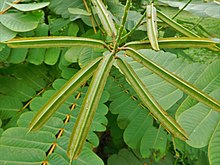Legume


As a legume , the characteristic is scattered fruit of the legume or legume called. In the kitchen, it is not the fruits themselves, but the seeds enclosed in them, which are usually air-dried when used , are referred to as legumes.
Plant anatomy
In botany, the legume, usually simply referred to as the pod, is one of the fruit shapes. It is defined as a dry (not fleshy) scattered fruit that consists of only one carpel and that opens both at the ventral seam and at the back seam when ripe. This is where it differs from the follicle , which also consists of only one carpel, but only opens along a single seam (on the underside or belly side). The individual valves of the pericarp of the legume are also known as valves . Legumes are characteristic of legumes, in which each flower forms a pod. However, they are less common in other plant families.
The fruits of legumes are usually referred to as pulses. However, this is not always correct by definition. In the course of the history of development, the legumes developed several times from opening legumes to non-opening ones, i.e. basically closing fruits , such as the fruit of the tamarind tree ( Tamarindus indica ), the peanut , the American gleditschia or the carob tree , as well as the clover ( trifolium ) u. a. However, these are not identified separately. The fruit of the peanut is morphologically controversial; some believe it is a real nut fruit . But z. B. the fruits of the legume genera Myroxylon and Machaerium , they are wing nuts (Samaras).
The pod looks similar to the pod , but is easily distinguishable from it by the lack of a partition inside. Contrary to the botanical classification , the pods of beans , peas and other legumes are called "pods" in the standard language .
The broken fruits are special forms ; Limbs and frame sleeve , and not jumping up legumes. The “coccum” is a special form, which is formed from just one carpel and opens up along two seams; it stands between an opening stone fruit or a capsule and a legume. Also because the term legume stands for the fruits of legumes, a differentiation is necessary. It comes z. B. in the nutmeg family and in the silver tree .
The pointed and non-opening legumes of the cassia are divided transversely by cardboard-like, interseminal partitions (septa). Those of the bicapsular senna are divided transversely and longitudinally. Fanned and twisted legumes can also be found in horn clover . The pods of the senna alata and the goa bean are winged. Furthermore, there are only openings (gutter sleeves; only with a slot) at the belly seam, as with the coral trees . There are also spirally rolled up legumes (cochlea, snail-shaped) such as snail clover or alfalfa .
Hemi legumes are also possible; Here, the individual flaps with the attached seeds serve as diaspores , as an organ for the spread of wind , such as. B. Acacia tenuifolia or Erythrina variegata . They are among the wing fruits . However, legumes that do not open are also spread by the wind, as is the case with the Dalbergia .
Those that only open when it rains also have a special shape.
Legumes in the human diet

Due to their high protein content and because of the possible large yields on small areas, the fruits and seeds of legumes, rarely classified as legumes , are an important part of human nutrition worldwide. They are practically indispensable, especially for low-meat, vegetarian and vegan foods.
Often found in kitchens around the world are u. a. Beans , peas , peanuts , chickpeas , lentils , flat peas (sweet peas) and soybeans , lupins or lupine protein .
Others
The year 2016 was approved by the World Food Organization of the United Nations (FAO) under the motto seeds to eat for a sustainable future ( nutritious seeds for a sustainable future ) as the ' International Year of legumes ' ( International Year of pulse declared).
Web links
Individual evidence
- ^ Wolfgang Franke : Nutzpflanzenkunde. Thieme, Stuttgart, New York, 1985, ISBN 3-13-530403-5 , pp. 40 and 52.
- ↑ Berit Otto: Characteristics of seeds, fruits, generative germinules and generative diaspores. In: Series of publications for vegetation science. 38, 2002, pp. 177-196.
- ^ Joachim W. Kadereit , Christian Körner, Benedikt Kost, Uwe Sonnewald: Strasburger - Textbook of Plant Sciences. 37th edition, Springer Verlag, 2014, ISBN 978-3-642-54435-4 , p. 171.
- ↑ Annette Höggemeier & Veit Martin Dörken: Arachis hypogaea - peanut (Fabaceae). Plant portrait. Yearbook of the Bochum Botanical Association 6, pp. 175–178.
- ↑ a b Leendert van der Pijl : Principles of Dispersal in Higher Plants. Second Edition, Springer, 1972, ISBN 978-3-642-96110-6 , p. 72.
- ↑ Leendert van der Pijl: Principles of Dispersal in Higher Plants. Springer, 1969, ISBN 978-3-662-00801-0 , p. 125.
- ^ Hemi-legume at NYBG, accessed November 15, 2018.
- ↑ fao.org: International Year of Pulses 2016 .
